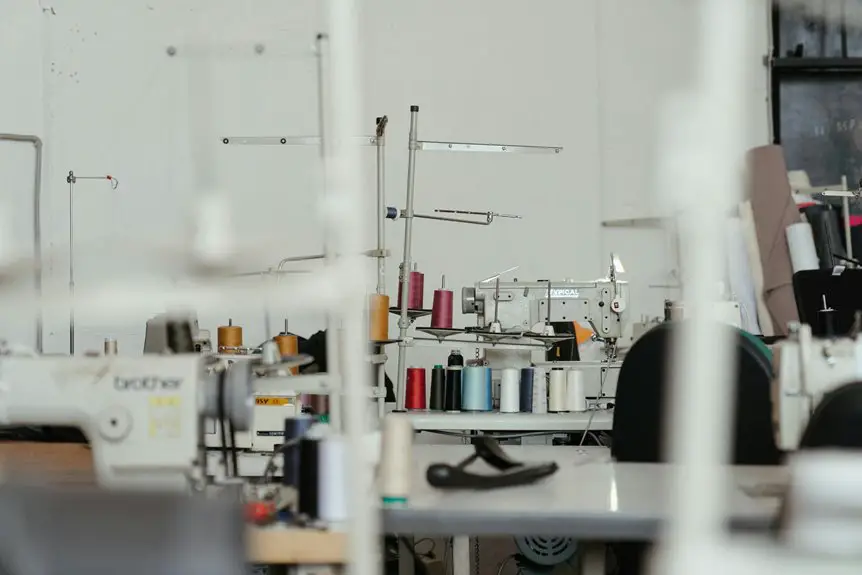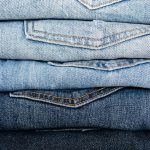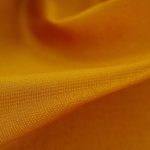You rely on nonwoven interlinings because they deliver excellent dimensional stability and uniform strength without adding bulk, ensuring your garments keep their shape and drape well. They’re lightweight, easy to handle, and fuse quickly, speeding up production while cutting costs. Compared to woven or knitted options, they reduce stretching and simplify application. Their versatility suits everything from formalwear to outerwear. Keep exploring, and you’ll discover how these qualities transform apparel manufacturing efficiency and innovation.
Table of Contents
Key Takeaways
- Nonwoven interlinings offer excellent dimensional stability, maintaining garment shape without adding bulk.
- They provide uniform strength and consistent performance, ensuring reliable quality in apparel production.
- Lightweight and flexible properties enhance garment comfort and draping for various clothing types.
- Quick bonding and easy handling accelerate production, improving overall manufacturing efficiency.
- Cost-effective and easy to apply, nonwoven interlinings reduce material and labor costs in mass production.
Advantages of Nonwoven Interlinings in Garment Construction
Nonwoven interlinings offer several key advantages that can enhance your garment construction process. You’ll find they provide excellent dimensional stability, helping your fabric maintain shape without adding bulk.
Since nonwovens bond fibers through heat or adhesives, you’ll enjoy uniform strength and consistent performance. They’re lightweight and flexible, so your garments stay comfortable and drape well.
Nonwoven interlinings offer uniform strength and flexibility, ensuring comfortable, well-draped garments with consistent performance.
Plus, nonwoven interlinings resist wrinkling, reducing the need for frequent pressing. You can easily work with them, as they’re simple to cut and sew, speeding up production.
Their cost-effectiveness also means you can keep expenses down without sacrificing quality. Overall, nonwoven interlinings give you reliable support, improve garment durability, and streamline your manufacturing while ensuring a professional finish every time.
Comparison Between Nonwoven and Other Interlining Types
While choosing the right interlining, you’ll want to weigh how nonwoven options stack up against woven and knitted varieties.
Nonwovens offer unique benefits that might suit your project better. Here’s a quick comparison:
- Structure and Stability: Nonwoven interlinings provide consistent thickness and firmness, unlike woven, which can stretch, or knitted, which offers more flexibility.
- Ease of Use: You’ll find nonwovens easier to handle and fuse quickly with fabrics, saving time compared to the sometimes tricky application of woven or knitted interlinings.
- Cost Efficiency: Nonwoven interlinings tend to be more affordable, making them attractive for mass production without sacrificing quality.
Impact of Nonwoven Interlinings on Production Efficiency
Because they bond quickly and handle easily, using nonwoven interlinings can greatly speed up your apparel production process.
You’ll spend less time aligning and stitching layers since these interlinings provide consistent adhesion without excessive manipulation. Their uniform structure reduces errors and rework, helping you maintain a smooth workflow.
Nonwoven interlinings also simplify cutting and pressing, allowing your team to move faster through each stage. Since they’re lightweight and flexible, you won’t struggle with bulk or stiffness, which often slow down handling.
Applications of Nonwoven Interlinings Across Different Apparel Categories
Although you mightn’t always notice them, interlinings play a crucial role in shaping and supporting garments across various apparel categories.
When you choose nonwoven interlinings, you enhance garment structure and durability without adding bulk. Here’s how they’re commonly applied:
- Formal Wear: They provide crispness and maintain lapel shape in suits and blazers.
- Casual Clothing: You get added comfort and subtle reinforcement in shirts and dresses.
- Outerwear: They improve insulation and stability in coats and jackets.
Future Trends and Innovations in Nonwoven Interlining Materials
As the apparel industry evolves, you’ll see nonwoven interlining materials becoming smarter and more sustainable. Innovations like bio-based fibers and recyclable components are making interlinings eco-friendlier, reducing environmental impact.
You can also expect enhanced functionality, such as moisture-wicking, antimicrobial, and temperature-regulating properties, which improve wearer comfort and garment performance. Advances in technology mean interlinings will integrate with smart textiles, enabling features like health monitoring or adaptive insulation.
Plus, manufacturers are developing lighter, yet stronger, nonwovens to boost durability without adding bulk. As a result, you’ll find these materials supporting both fast fashion and high-end apparel with greater efficiency.
Staying updated on these trends will help you select interlinings that meet evolving consumer demands and sustainability goals.
Frequently Asked Questions
How Are Nonwoven Interlinings Manufactured?
Like weaving a secret fabric spell, you manufacture nonwoven interlinings by bonding fibers through heat, pressure, or adhesives. You then create a sturdy yet flexible material that supports garments without traditional weaving or knitting.
What Environmental Concerns Are Associated With Nonwoven Interlinings?
You should know nonwoven interlinings often involve synthetic fibers, which aren’t biodegradable and can contribute to microplastic pollution. Their production consumes energy and chemicals, so choosing eco-friendly options or recycling is key to reducing environmental impact.
Can Nonwoven Interlinings Be Recycled or Reused?
Think of nonwoven interlinings as puzzle pieces—once used, they rarely fit new puzzles well. You can’t easily recycle or reuse them, so you’ll often find they end up discarded rather than reborn in fresh garments.
What Are the Cost Implications of Using Nonwoven Interlinings?
You’ll find nonwoven interlinings cost-effective because they reduce production time and labor. They’re generally cheaper than woven options, helping you save on materials and increase efficiency without compromising garment quality or durability.
How Do Nonwoven Interlinings Affect Garment Care and Maintenance?
Think of nonwoven interlinings like a trusty umbrella—they protect your garment’s shape during washing. You’ll find your clothes resist wrinkles and maintain structure, making care easier and extending your wardrobe’s life effortlessly.
- What Is PET Spunbond Nonwoven Fabric? - July 11, 2025
- How to Test the Quality of a Nonwoven Fabric - July 11, 2025
- The Benefits of Using Nonwoven Wallpaper in Your Home - July 11, 2025







